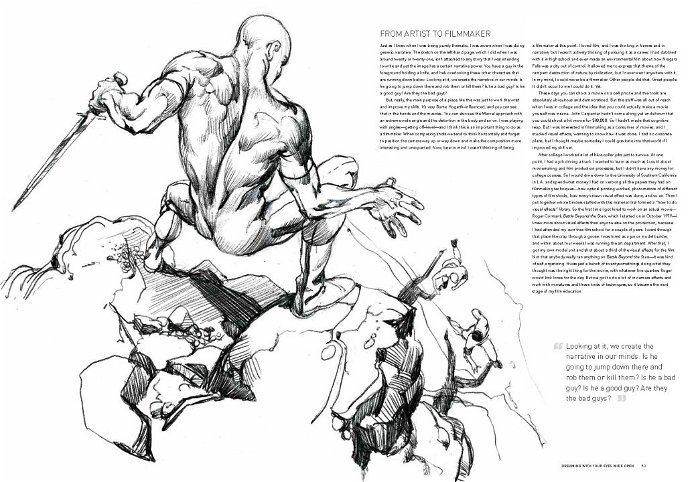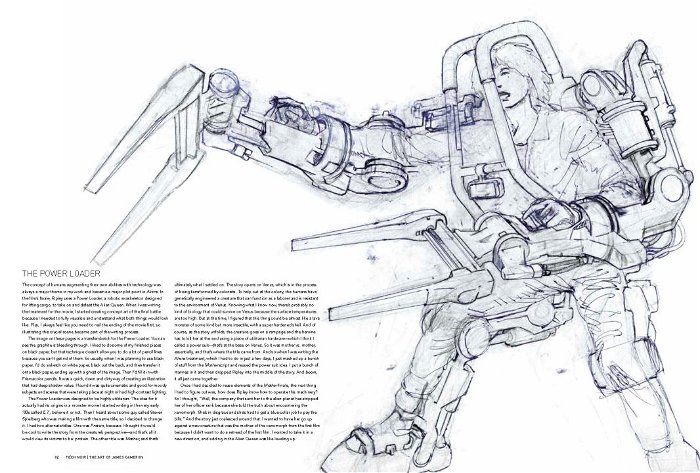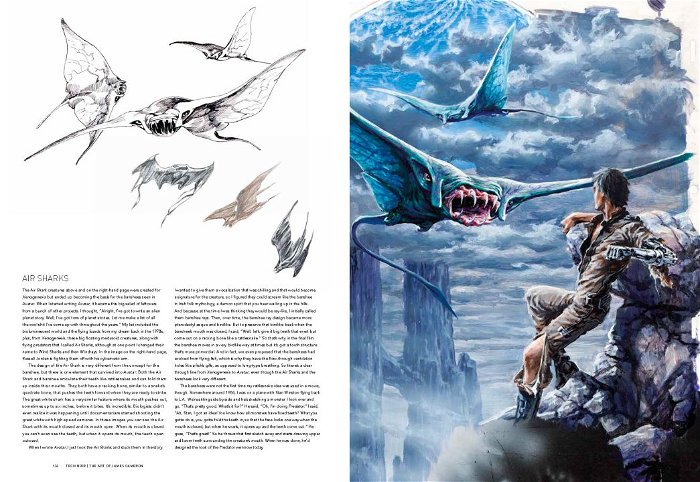James Cameron likes to draw.
It’s a hobby which helped bring films like The Terminator, Aliens and Avatar into existence.
Each movie also shares a pattern along Cameron’s brainstorming. A balance came from blending a believable image of man and machine. A lush, but hostile planet called Pandora was inspired by decades worth of ideas from an 11-minute science fiction short film in 1978. The blind fury of an alien queen would only be matched with Ellen Ripley’s will to save Newt. Along with a Power Loader that trades human reasoning for some industrial brute force.
Tech Noir is the latest book chronicling James Cameron’s career by showing more and telling less about his films. Specifically, readers are building their own narratives from every drawing. Just as Cameron did himself as he flash-froze ideas on paper before they faded away. Then saving the interpretation for later when it was time to make a science fiction blockbuster. To Cameron’s surprise, his interpretive sketches would fuel his curiosity later on. Including a random sketch of a stranded astronaut wandering a lifeless planet he drew at age 18.
“I was really better as a storyteller than as an artist”
“He can breathe the air, but he’s got no water. He’s walking across the endless dunes of a planet. What happens next? How does he get saved? How does he save himself? ” Cameron told CGMagazine in a roundtable interview.
“I realised somewhere along the way that I was really better as a storyteller than as an artist, because I want to know what happened. I want to know how it got resolved.”
There’s still plenty to decipher from Cameron’s evolving sketches as he grew up in Ontario. Pencils, pens and oil pastels would create new questions in a picture. For Cameron, the cliffhangers would go right into the heart of his current projects including Avatar 2.
“I want you to know what happened,” he said.
“Even if sometimes there’s a little bit of a cliffhanger ending. Or an ending that’s disturbing and asks questions. Although I tend not to make those films. I tend to make films that sort of button off, having completed a statement.”

Tech Noir collects Cameron’s personal drawings. But not without words from the filmmaker as he looked back at every sketch. Each one marked a certain point in his journey of creating Hollywood’s most iconic stories. Early (spontaneous) brainstorming would be started across early short films and B-movie productions.
The book is also named from a term Cameron coined in 1984.
When The Terminator came to life in theatres, so did the words Tech Noir. First as a neon sign that gives off Sarah Connor’s location to the menacing T-800. According to Cameron, Tech Noir addresses a bleak scenario of technology controlling humanity’s future. It’s a theme that was most visualized in The Terminator’s sequences across 2029. As Earth was shaped in the eyes of Skynet’s mechanical androids. For humans, this tech-noir reality was a nightmarish wasteland. Filled with rubble for survivors to hide in as Terminators passed by. Completely unfazed as the manmade beings gunned down resistance fighters to near extinction.
“Everybody is building on what’s gone before”
Even as James Cameron spends his free time digging into other director’s works, the “DNA of ideas” starts coming back to him.
“Everybody is building on what’s gone before,” said Cameron, adding it’s normal for concepts to be reinvented in a different lens among directors. He cited media, including Halo, for familiar “techno-military” themes. But also the semi-dystopian 1959 novel Starship Troopers by Robert Heinlein, which stuck with Cameron during his brainstorming sessions.
He also continues to be surprised by new ideas from filmmaking techniques. Specifically, using a GoPro for filming an undisclosed Avatar 2 sequence in New Zealand.
“So I’m making a movie that’s — I don’t even want to say how much it’s costing — and because we’re shooting in 3D, it’s a lot of recording media,” said Cameron, recalling an experiment by using different cameras to capture a stunt.
“Because it was the second unit, we didn’t have a lot of our normal stuff. And they said, ‘Well, we only got three cameras.’ Three 3D cameras. Which is actually six records, right? I said ‘get a GoPro.’ I cut the scene yesterday, and the GoPro shot was the best shot! So we’ll do a 3D conversion on that. It’s a 4k shot. I did a little bit of a post move on it,” he added.
It’s one of the meal piece stories behind producing Avatar 2. Including Cameron’s willingness to learn from the DNA of other works. Ironically, even if other directors picked up on their own take on tech-noir.
“But you’re constantly learning, you’re constantly expanding. You’re constantly getting feedback signals from other people out there that have access to the tools (GoPro). Sometimes I’ll see a sequence and I just want to know how it was done. I’m going to call the filmmaker up and ask him how they did that,” he said.

Concepts of Tech Noir were laid bare (and metal) in Cameron’s vision for Aliens. Without spoiling the book’s contents, Cameron’s earlier drawings of the 1986 sequel showcase humanity’s dependence on space technology. Familiar tools like the iconic Power Loader were made with a combination of industrial cargo clamps. Including just enough “human” separation for Ellen Ripley to manually control it as an exoskeleton. The prop reflected Cameron’s vision of a dependable tool which could be made possible. From the hardware clamps gripping the Alien Queen’s neck. To the exosuit’s purpose, as a “creature” that space colonies rely on for off-world labour.
Cameron’s notes around his art would even flip the tech-noir concept around in 2009’s Avatar and its sequel. Starting with the bleak idea of humans draining the Earth’s resources in 2154 and then settling in Pandora to rinse and repeat, Tech Noir dove into a deeper contrast with the Na’vi. An indigenous blue species thriving in nature without a single watt of power. For Avatar’s protagonist, Jake Sully, a night without technology would turn into a fight for survival. Until he learns to co-exist with Pandora’s natural order of things. Then drive humanity back to the stars. A concept from pilot project Xenogenesis inspired one such a narrative in a single hand-drawn frame. As a marooned cyborg pilot struggles to fight off a hostile planet’s “air sharks” without help.

Though Avatar delivered an ending of its own in 2009, audiences would be left imagining what happened afterwards. That’s until Cameron’s upcoming sequel changes the universe once again, frame by frame. Tech Noir doesn’t explicitly give details about Avatar 2. But much of the sequel’s foundations were laid in Cameron’s sketches.
“I think it’s that realization of when I look back over the body of work, I realize a lot of it is design-oriented. It’s just aesthetic. Maybe it’s a homage to technology. But it’s also storytelling. It’s very narrative driven.”
Tech Noir: The Art of James Cameron hits bookshelves on Dec. 14, 2021. The nearly 400-page art book contains written anecdotes by James Cameron and origins behind his drawings. Readers also get a glimpse at never-before-seen concept art behind films including Aliens, The Terminator, Avatar and Titanic across his career.




